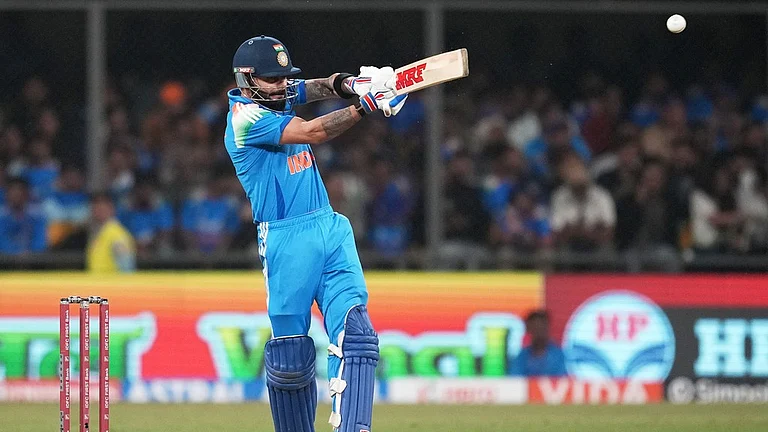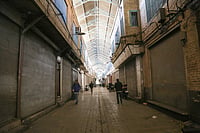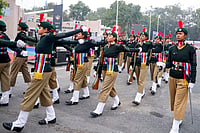Gokarn and Hampi are the new havens that have mesmerised hundreds of shoe-string-budget visitors from Europe, Australia, Israel and the US since the early '90s. Not for a darshan of Lord Shiva's atmaling in the seaside town or a look at the stone marvels in what was Emperor Krishnadevaraya's capital, but for the sun, exotic landscapes and abundant seclusion. The non-conformist, non-conventional image they flaunt has caused them to be labelled hippies by the locals—a tag borrowed from neighbouring Goa. The termhas been reinforced by their passion to shed what little fabric they cover themselves with and get stoned on grass and charas to "float like that little fishing boat on the seas".
The discovery of the two towns by hippies started in the early '90s, though Hampi had always attracted 'serious' international tourists who visited the ruins for its historical richness. The discovery was triggered by the necessity to find an alternative to Goa which is seen to have lost its USP—seclusion. "Goa is very crowded now," says Anna, who speaks with a German accent but says she belongs to "any place". "Gokarn is a shanty kind of a place, more basic. It's not crazy like Goa," adds a German couple, medical students from Hamburg, lazing on Kudle beach in the morning sun.
About 11 lakh tourists visited Goa in 1995, of which 9.5 lakh were Indians, resulting in escalating prices and stretches of secluded beaches swallowed by five-star resorts. Gokarn and Hampi, while vastly different as far as the setting is concerned, offer much the same for the hippie looking to relax with a joint. Situated in Karnataka's Uttara Kannada district, Gokarn nestles among a series of hills and hillocks which embrace the Arabian Sea to form eight picture-postcard beaches. Two of these, Dodd-abaile and Sannabaile, are popular among Indian pilgrim tourists and excursion groups due to their easy accessibility. The remaining beaches are inhabited by loin-clad overseas visitors for whom life on the beaches is sheer exotica with green hills and small farms in the background, swaying palms, a gentle sea and plenty of sun.
That there is no sea or sand at Hampi in Bellary district makes little difference. Just as in Gokarn, domestic visitors limit themselves to visiting the ruined monuments in the World Heritage site while the hippies make themselves comfortable among the rocks on the hillocks beside the Tungabhadra river.
Gokarn today receives an estimated 2,000 hippies during the November-March season while foreigner registration records at the Hampi police outpost registered about 1,500 of them in 1995. In December 1995, even before the peak 'hippie season', 650 hippies had stayed in Hampi for periods ranging from two days to two weeks.
"We Sell Almost Anything" reads a sign outside a grocery store on Gokarn's maintemple street, a pointer to the fact that the temple town of about 20,000 people has been totally sold to the limited dollars brought in by the backpacker. "Most of these people are poor European tourists," says Mahabala Nambiar, 33, who owns a small beach at Tattebaile where he plans to start a "cultural centre" to offer glimpses of India to the "foreign tourists".
"About 20 per cent of them cannot even afford to pay their winter electricity bills back home in Europe. Gokarn for them is a cheap and wild place," he adds. But for the local who did some farming on his land off the beach or the Brahmin who lived on performing shraaddh for forefathers of visiting pilgrims, visitors with dollars are big business. For six months from November, about 15 tea shops-cum-restaurants-cum-lodges sprout on the two most popular beaches frequented by the hippies—Kudle and Doddabaile. Om beach is the new name given by the visitors to Doddabaile, as the sea forms two crescents and is joined by an extension of rock and sand into the sea in the form of Om in the Devnagri script. These businesses, just as those on the temple streets of Gokarn and Hampi, sell anything the visiting hip-pie requires, ranging from macaroni, pasta, peanut butter, Coke and beer, to imported cigarettes, cigarette paper to make joints,polaroid film and, of course, toilet paper. "They taught us to make macaroni, pasta, different types of sandwiches and milkshakes," says Govind Nagappa Gowda, 20, who runs a business on the 22-acre farmland on Om beach.
The biggest demand, though, is for accommodation. Each of the businesses on Om beach has built about half-a-dozen huts which cost between Rs 20 and Rs 40 a day. With a mattress or mat on the floor as a bed, and without electricity, bathrooms and toilets, the milieu couldn't get wilder for the hippie while the proprietor, who does not respect traditions of licences and taxes, laughs his way to the local cooperative bank. Govind, for instance, earns an easy Rs 800 a day while his younger brother who runs another similar business, also on Om beach, rakes in an equal amount. And then there is always the option of one of the 30 houses in the temple town that offers rooms, or the beaches where the trees help make a perfect hammock.
The archaeological importance of Hampi, however, has placed some restrictions on the backpacker visiting the ruins. Visitors are barred from camping in the hillocks and have to make do with houses that have been converted into cheap lodges and guest houses. Eight such facilities have come up in the last three years, while the number of restaurants and tea-shops catering to the visitors is about 50 in a town with a population of 1,100.
The good business, however, is not limited to Coke, sandwiches and toilet paper rolls. Large quantities of grass and charas have accompanied the hippies to Gokarn and Hampi and the businesses on the beach sell 10 gm of charas for upwards of Rs 200 with the price touching Rs 400 during peak season. "We always grew a little grass for ourselves in our farms but now we get supplies from these hippies," says Nagaraj, 23, a drug peddler in Hampi. According to him, supplies come from Bombay, Pune, Goa and Gokarn. Adds Sridhar, 21, a college dropout from a priest's family in Gokarn, who smokes half-a-dozen joints a day: "These fellows (shopkeepers on the beach), buy grass and0 charas from the foreigners during the non-peak season at Rs 150 for every 10 gm and sell it for double that amount during the peak season." For the hippies who enter India through Bombay or Delhi, the source is claimed to be Kulu and Manali in Himachal Pradesh. Restaurants on the main temple street and 'boys' in Gokarn also sell joints. Galeppa, 45, once a firewood collector in Hampi, now has a cottage industry making clay pipes to smoke narcotics. "Each pipe costs Rs 25," he told Outlook when traced atop a ruined temple, heating freshly-made pipes.
Police in both towns admit the free movement of narcotics. While the Gokarn police cite shortage of staff and absence of "specific directions from above to conduct raids", the Hampi police reveal that a kilogramme of grass was seized in three different cases and five persons arrested during 1995. Shiv Hegde, who runs an accommodation facility at Kudle beach in Gokarn was arrested in early 1995 by the Central Customs and Excise for possession of an undisclosed amount of narcotics, but was acquitted eight months later. In Hampi, where the Tungabhadra forms the border of Bellary district, the hippies cross over to the hillocks in Raichur district where the nearest police station is situated 12 km away. The DIG of Karnataka Police (Western Zone), Chandrashekar, under whose jurisdiction Gokarn falls, has promised to take necessary action. However, Gopal Hosur, SP, Bellary district, feels the steps taken in Hampi could be insufficient. Says he: "We know that they bring in and use narcotics. But they cross the Tungabhadra into a different district. We have requested the upgrading of the Hampi police outpost into a full-fledged police station."
The irony of the situation, however, is reflected in the fact that the traditionally conservative population of Gokarn and Hampi turns a blind eye to the not-so-clandestine drug peddling and licentious behaviour and, in fact, is overtly protective of its visitors for the simple reason that they bring good business. So V.D. Dikshit, managing trustee, Mahabaleshwar Temple, Gokarn, was not surprised when he received little support for his plan to write to Prime Minister Narasimha Rao to end the hippie menace in Gokarn. Says Dikshit, who sent copies of the letter to the chief ministers of Karnataka, Goa, and Maharashtra: "Most families in Gokarn benefit from tourists. So no one wants their entry to be restricted, let alone be banned."
Jayant Kaikini, 40, a biochemist and writer from Gokarn, who has won two Sahitya Akademi awards for his poetry, admits the influx of foreign tourists has influenced the locals, especially the youth. Says Kaikini: "Perhaps this is Gokarn's way of rebelling against centuries of segregation from the outer world."
However, with a local population enamoured by the wallets of the hippies, the hippies high on intoxicants and the intoxicating setting, and a police force in slumber, Gokarn and Hampi stand as classic examples of the ruin unchecked tourism can bring about.


























